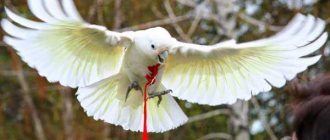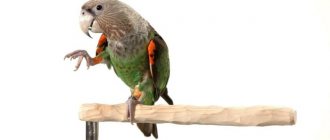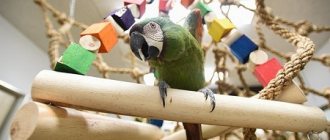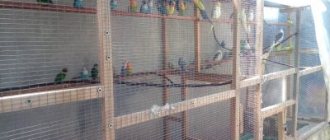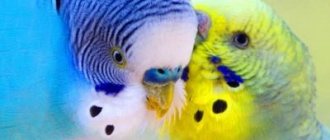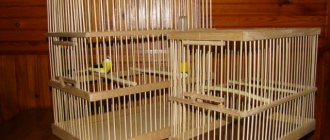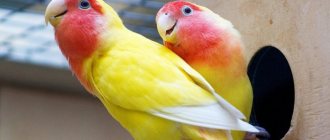DIY parrot ladder
Pet parrots are very popular pets: they do not take up much space in the apartment and bring great joy to their owners, especially children. To diversify the lives of birds, many owners equip their homes with various toys: bells, mirrors, hanging swings and ladders. All these items are available in abundance in specialized stores, but it’s nice to make something for your pet with your own hands - for example, a ladder. The article will discuss how to make this accessory with your own hands.
Popular toys for budgies, cockatiels, lovebirds
So, what toys do small and medium-sized birds need? They are subject to a number of requirements. They should be bright, colorful, and noisy if possible. Birds are often very active. That's why they love it when everything creaks, rings, rustles, etc.
The following toys are suitable for small and medium parrots:
- Bells, rings, ladders, beads.
- Rattles, a Kinder Surprise “egg” filled with some kind of cereal. They will captivate the parrot for a long time.
- Beads made from plastic bottle caps.
It is recommended to place everything in the cage that can be dropped or thrown. If objects make loud noises, the bird will be delighted.
How to make a ladder with your own hands
Making bird fun of this kind will not be difficult and will not take much of your time.
What trees are they made from?
It is very important to know which types of trees can be used to make an entertainment ladder for a parrot, and which ones are absolutely not suitable for this.
- birch,
- cherry,
- apricot,
- grape,
- viburnum,
- linden,
- maple,
- aspen,
- sea buckthorn,
- raspberries,
- rowan,
- hazel,
- plum,
- apple tree
- cherries,
- chokeberry,
- currants
It is unacceptable to use:
- elderberry
- oak,
- pear,
- lilac,
- acacia,
- bird cherry,
- poplar,
- ash,
- a coffee tree,
- all types of coniferous trees.
In general, any wood that contains tannins or pine resin is prohibited.
Tools and materials
The work will require the following materials and tools:
- long sticks (about 40 cm) made of approved wood, such as maple;
- short sticks (10 cm) made of wood of a contrasting color (birch);
- plastic clamps for fastening;
- gardening scissors;
- stationery knife;
- stationery scissors;
- old toothbrush;
- container for soaking sticks;
- emery cloth;
- pencil;
- ruler.
Manufacturing process
Step-by-step instructions for making an entertainment ladder:
- Cut branches from trees using garden shears.
- Rinse each branch from dust and dirt under running water.
- Soak the material for 2–5 hours, completely immersing it under water: this will help destroy pathogenic bacteria and parasites.
- Carefully clean each branch with an old toothbrush.
- Pour boiling water over the preparations.
- Dry the material.
- Choose sticks of suitable thickness (1.5–2 cm).
- Trim each branch with a utility knife to the desired length, leaving two long ones and several short ones.
- Sand the edges of each cut with sandpaper.
- Using a pencil and a ruler, measure the same distance (5 cm each) on the two long sides of the future ladder to place the crossbars.
- Place the crossbars on each side panel one by one and secure them with plastic clamps.
- Use scissors to cut off the protruding tails from the clamps, making sure that there are no sharp cuts.
- Install the ladder in the selected location in the bird’s home, attaching it to the rods or to the main crossbar in the cage with clamps.
Video: how to make a ladder for a parrot
Children's inheritance to the delight of the parrot
If there is or was a small child in the house, there will be a lot of toys left from him that will be great entertainment
for a parrot with a small addition.
Rope fun
From bendable rope you can create a real corner for a parrot
. Due to its properties, it takes any form. For a parrot you can use it to make a swing not with a crossbar in the middle, but a round one. No less interesting to your pet will be a variety of curved stairs and arches, for the manufacture of which it is enough to bend the rope into the desired shape.
If you only have an ordinary rope with a diameter of no more than 0.5 cm, why not make a bungee out of it, on which the parrot can swing
. Knots are tied along the length of the rope at a short distance from each other. A wooden perch or twig is tied below. The bungee, like the swing, is attached to the ceiling of the cage.
Safety regulations
All objects that surround the parrot must be absolutely harmless.
Here are some safety rules to remember:
- It is unacceptable for handmade products to have sharp or prickly edges.
- Stairs for pets must be made exclusively from environmentally friendly materials and acceptable types of wood.
- Staircase parts must have reliable fastenings.
- For convenience, the accessory is placed at an angle of 45°.
- The rungs of the ladder should be placed at equal distances to avoid injury to the parrot's legs.
- It is unacceptable to use cotton cords or ropes in the form of fastenings for stairs: during play, the pet can dishevel this material and swallow its particles, which will lead to blockage of the bird’s gastrointestinal tract and its death.
As you can see, it is not difficult to make an entertainment attribute in the form of a ladder for a parrot, and it does not entail large material costs.
By spending a little free time and showing your imagination, you can please your pet and diversify his leisure time. And these funny birds, in turn, will gladly respond to your attention with their activity and fun.
What toys does a parrot need?
To entertain your feathered friend, so that the bird does not get bored when it is alone and does not get sick against this background, many game items have been invented that can be divided into types:
- Developmental — provide the opportunity to realize the pet’s capabilities given to it by nature. While solving a puzzle, the parrot performs certain actions and finds a tasty treat hidden in a toy. Foraging has several levels of difficulty, which gives the parrot the opportunity to gradually develop, improve and consolidate its skills.
- Gnawing - for legs and beak, these are pendants made of wood, acrylic or plastic, as well as wooden and paper figurines. These devices will protect your property from damage.
- Hanging, climbing or climbing machines - ladders, ropes, rings, bungees. These toys will help the bird always be in excellent physical shape.
- Motivating - will help satisfy the parrot's natural curiosity. It is necessary to give the opportunity to untie something, unwind or take out an object.
Important! There should be no more than two toys in the cage, placed so that the middle of the house is free for the parrot to move around.
Beautiful swing
You will need:
How to make a beautiful swing
- Choose multi-colored beads. You can use buttons. Remove the swing and disconnect the wire at the top.
- String the beads on the wire, remembering to leave a small gap between them so that the parrot will find it interesting to move them.
- Fasten the ends of the wire and hang a bell at the junction.
- Hang a beautiful swing in your budgie cage.
Where should it be placed in the cage?
It is important to arrange the toys selected for the bird in such a way that they do not cause inconvenience to the pet. In this case, it is necessary to take into account the size of the cell. If the parrot's home is small, you should not place many objects in it. The bird should not touch them when moving around the cage. The pet is not interested in using the same objects every day, so it is necessary to alternate the accessories in the cage, inviting the parrot to play with them.
A suitable place to place them is a specially equipped playground. In this area you can hang 2-3 accessories and a swing. If your pet has only recently arrived at home, you should not offer it toys. The feathered one will focus all his attention on bright and interesting objects and will be reluctant to make contact.
Willow gnaws
You can make very useful toys from willow twigs for parrots with your own hands by collecting raw materials somewhere outside the city on the banks of reservoirs. Before you begin, soak the willow branches in boiling water. By doing this, you will not only give the tree greater flexibility, but also protect your parrots from infections and unnecessary microbes.
- Weave balls from the branches and hang them with wire from the roof of the cage. The result was original toys and necessary chews. Birds not only sharpen their beaks on wood, but also replenish their supply of useful vitamins.
- You can go further and make an original swing from willow sticks, attaching them to a ball with metal chains, and hanging a bell to complete the feeling.
Types of Bird Toys
There is a wide range of toys on sale and sometimes it can be difficult to choose, so let’s look at what categories of toys there are that help enrich and make the lives of our birds interesting.
Forages/forages:
Foraging toys with holes encourage the bird to forage as it would in the wild. Foraging should be placed at varying heights throughout the cage to encourage movement and exploration.
Forage toy made of coconut and dry mango seeds, option suggested by Alice Ioannou:
We have dried mangoes before and added them to our picker, where they were always noticeably “gutted”! There were enough seeds for a toy, so we decided to put them to work and make a toy from mango and coconut seeds. To make the toy we needed:
*Jute or sisal twine *Two coconut shell halves *Small pieces of cracked coconut shell *Dried mango kernels
Let's start by preparing all the parts for assembly: we make holes in the mango seeds closer to the end (I did this with ordinary scissors), we drill all the small pieces of coconut shell in the middle. We also make a hole in the middle in both halves of the coconut shell. We “reward” one of the halves with 8 holes closer to the edge (the location of the holes is visible in the photo). Now all the parts are ready for assembly.
Pieces of coconut shells, we string them on a rope, separating each piece with a separate knot, in order to avoid “sliding” down. Then we stretch the string into the holes of the mango seeds and tie it with a triple knot. We do this with all the bones. The next step is to insert our prepared mango seeds into the holes of the coconut shell, with 8 pre-drilled holes. I tied each cord with a strong knot. Our first coconut shell, “decorated” with mango seeds, is ready (photo in the middle). Now we stretch our “garland” of pre-assembled pieces of coconut shell into the central hole and string the other half on top of the entire structure (the location is clearly visible in the last photo). Voila, the toy is ready!)
As always, Madame watched with interest as we made it, and became especially animated when she saw a lot of mango seeds. If someone’s birds love toys that rattle, this is what you “need”! Toys made from coconut shells always differ from others in their special “sound”. This toy is also a chew toy
.
Chew toys:
Gnawing is a major activity of birds in the wild, especially during the breeding season when birds actively make nests in tree trunks. It is essential that birds are provided with wooden chew toys at all times. Wooden toys will provide your parrot with hours of gnawing and chewing pleasure. Don't be upset that the bird is destroying them. This means that they benefit her. Large parrots will benefit from toys made from hard wood. For small parrots, toys made from soft wood, such as pine, grapevine, apple tree, etc., are perfect.
A good and useful chewing toy is made from sepia, or as it is also called, “cuttlefish shell.” Here is the option suggested by Alice Ioannou
To do this, we collected the main material on the shore - cuttlefish shells, you can buy them at a pet store, but we have a lot of them on the shore. We will need: Cuttlefish shells of different sizes (in my case there are three, all of different sizes). To do this, we collected “basic material” on the shore - cuttlefish shells, you can buy them at a pet store, but we have a lot of them on the shore. Cotton rope Wooden parts of other toys left “idle” Bell
The manufacturing process looked like this: First, I made holes in the shells with thin scissors on the soft side and then enlarged the hole to make it easier to pull the rope through them. Then she began to gradually attach one cuttlefish shell after another in order of decreasing size. When the shell structure was assembled, I secured the wooden parts in random order. And finally, I attached a bell. It only took me about 10 minutes to make this toy, and our wavy pet began to clink and chew on it. Cuttlefish shell is a healthy addition to your diet, if you remember! And the presence of the bell only provoked him because, with each bite, the structure “ringed”
Exercise toys:
People use many exercise machines to exercise all the muscles of the body. The same applies to birds. Poultry really needs a variety of exercise toys that will train the muscles in different parts of the body. Various types of swings will perfectly develop the ability to balance, and ladders, nets and ropes will force the bird to move more and develop tenacity, strengthening the strength of the fingers.
Mechanical and manipulative toys:
Birds are very intelligent and inquisitive creatures. Many of them actually enjoy untying the knots and loosening the nuts and bolts in their cages. Puzzles and toys that require manipulation should be quite challenging. They will stimulate such birds to think and exercise their bodies.
A variant of a manipulative toy proposed by Alisa Ioannou for Grays:
The simplest manipulative toy that a bird can hold in its paw. For this we will need: Jute or sisal rope Two boxes of sweets for children, such as “Kinder Surprise” Small ringing bells, which we will put inside the “boxes”.
Making the toy is very simple - first we measured and cut 9 pieces of rope, then we wove a braid out of every 3, securing it at the end to avoid unraveling. And then from the three ready-made braids we weave one large one (at the end securing it with a separate bandage). The last step is to pull the ends of the braids into the holes made in advance in the “box”. Let's do this from both ends. And finally, before closing each “box”, she put small bells inside for sound and tied it with a knot along the entire length to make it more convenient to hold it. You can hide something else or, for example, a nut, so that the bird will try to open the “secret box”. Thus, we have a toy that can be held in the paw, chewed, unbraided and tugged at the fibers. And also look for little “secrets”. Our Gray is very interested in this toy.
Filled toys:
Toys with paper or fabric or rope filling are suitable for birds who love to constantly fiddle with their feathers, preventing them from gaining a foothold or distracting them from this very bad habit.
Paw toys:
The parrot's paw can very skillfully grasp and hold small objects. These are small, lightweight toys that the parrot can manipulate and chew on. Such toys develop paw dexterity very well and the bird gets a lot of pleasure from gnawing and chewing.
Comfort toys:
In the wild, birds often come into contact with their relatives, clinging to them while sitting on branches or in a nest. In a cage, some birds, especially when they are alone, like to snuggle or crawl into something soft and cozy. This reduces their stress and gives them a feeling of security. This type of toys includes various rings with thick and soft winding, pipe tunnels.
That, in fact, is probably all I wanted to tell you about bird toys. It remains to talk about safety and the materials from which bird toys are made.
Ladder
For budgies, there is nothing more interesting than climbing and descending all sorts of stairs. And for their owners, there is nothing easier than making such toys with their own hands from thin rope and wooden sticks.
- Cut several identical sticks. Branches of pear, bird cherry, poplar and oak cannot be used when making toys for parrots.
- Cut notches along the edges to prevent the rope loop from slipping. Sand the sticks.
- Tie a ladder and hang it in the cage.
In the same way, you can make a swing or weave other toys from rope.
Choosing a safe toy. Materials for toys.
There are NO toys that are 100% safe! A parrot's safe play depends entirely on its owner. Choosing the right toy is one way to help keep our birds healthy and away from injury. There are several factors to consider when choosing a safe toy for your bird: – Suitable size – Materials and design – What kind of toys your bird prefers and its play style.
Any toy can be dangerous if the size is incorrect. For example, a toy intended for a small bird often contains components that could pose a choking hazard to larger birds. Conversely, toys designed for large birds may pose a entrapment hazard to smaller birds. Small, fragile plastic pieces may be perfect for a small bird, but are easily broken into sharp pieces by the force of a large parrot's beak.
Tree:
Birds are constantly gnawing and chewing something. And wood is an excellent material to satisfy these natural needs. Parrots most often play with wooden toys. Wooden toys are meant to be destroyed. Some bird owners may be frustrated by the destructive behavior of their parrots. But nevertheless, we need to accept that gnawing and chewing is a natural instinct that is vital to the psychological and physical health of the bird. And if you only give your parrot acrylic, plastic toys, believe me, they will find another, more expensive, way to satisfy their needs (doors, furniture, etc.). It is important to know what wood is safe for your bird. Both soft and hard wood species are used to make toys.
Making toys from plywood is strictly prohibited! Plywood is made by gluing together several sheets of wood under pressure and can be treated with arsenic; glue and arsenic are extremely dangerous for birds. The same applies to chipboard.
Birds can see colors, so color makes wooden toys more attractive and interesting to birds. Manufacturers, as a rule, paint wood with food or vegetable dyes. You should not buy scented wooden toys. Flavorings often contain fruit sugars, which are an ideal environment for bacterial growth, and the smell encourages birds to ingest pieces of wood.
Never buy toys that are varnished (keep in mind that the varnish coating may not have the usual varnish shine, always pay attention to the smell of the toy - buy something that smells only of WOOD).
Ropes:
Toys should only use strings and ropes made from 100% natural fiber. These are cotton, hemp (jute), sisal, hemp. Synthetic ropes and ropes should never be used as they can cause serious injury and cuts due to the strength of the threads if the bird becomes entangled in them, chewed such threads can become “needles” inside the bird. Bird owners are required to check rope toys daily. And if they are very disheveled, then you can trim them or throw them away altogether.
Chains:
The chain links must be well soldered and free from sharp joints, burrs and cracks. Make sure the link sizes are appropriate for the size of your bird. If the link is very small, the bird may break fingers or paws stuck in it. Long chains also pose a danger, since during active play the chain can wrap around the bird's neck.
Fasteners (carabiners):
This part of the toy can be very dangerous. Because good fastenings are expensive, many manufacturers use potentially dangerous items such as split key rings or carabiners for dog leashes and harnesses.
Important!!!! There should be no galvanized parts in the parrot's cage or toys!!! Zinc is very toxic to parrots.
Plastic in parrot toys:
When purchasing a toy with plastic components, the bird owner must consider the quality of the plastic. You should not buy toys made of thin, brittle plastic, because when they break, they create sharp cutting edges and, if accidentally swallowed, this can lead to ruptures and injuries to internal organs. Plastic toys intended for small parrots should not be given to larger birds.
Rings:
When choosing a toy with rings or plastic chains, make sure the rings are large enough so that the bird's head cannot get stuck in them.
Bells:
Make sure the bell beater cannot be removed by the bird. Choose a bell that can withstand the pressure of the bird's beak.
PS Always remember - just because the label says a toy is safe, this does not mean it is suitable for your bird.
Recipe for a gnawing toy for Grays from
Alisa Ioannou .
Orange peel halves, loofah, rope. Loofah filling: hazelnuts, hot dried peppers, rosehip and rose flowers, carob pods, almonds in shell. And for decoration and sound: dried apple and carob pods. It is very easy to assemble - we string the orange halves onto a rope, securing each half with a rope knot so that the half does not fall down. Then we insert the loofah into the orange halves and “fix” all the other ingredients in the loofah. Author Svetlana Gerova First published in the group I Love Parrots. Photos of homemade toys for parrots taken by group members and administrators were taken from the group’s album. Add examples of your bird toys in the comments.
Training apparatus
For this bird fun you will need a small plastic bottle or paper towel tube and wooden sticks.
- Seal the bottom of the tube.
- Drill or punch side holes of such a diameter that the sticks fit tightly into them without falling out or twisting.
- Fill the container with washed and calcined river sand.
Types of stairs
The bird can diversify its leisure time by going up and down the stairs. So why not bring her joy, especially since making a staircase is not difficult, you don’t need to spend a lot of time, effort or buy expensive materials. All you need are items that you have on hand or that are easy to find, such as thin rope and wooden sticks. We will introduce you to different design options; which visa to choose is up to you.
- You can take an old thick chain and insert short sticks into the links - ladders. Each of them must be fixed in the link, not move or fall out. The chain can be secured with a hook to the top of the cage. You can attach a mirror to the chain, the bird will look at itself with interest, moving its paws along the chain of stairs. Attention! The hooks and edges of the sticks should not be sharp. The edges can be decorated with beads; the bird will like this and protect it from injury. But remember that the beads should not contain zinc, copper, brass and other toxic metals.
- From small branches of pear, bird cherry, oak or poplar you need to cut identical sticks (9-10 cm long). In each of them, make small notches near the edge, and sand the sticks. Use a thin rope or cord to tie everything together in the shape of a ladder.
- Attention! The cord or rope must be strong enough; if the parrot plays too hard, it can fray so much that flakes and shreds remain. The playful bird may mistake them for a treat, resulting in blockage of the gastrointestinal tract and the death of the bird.
- You can take long, even sticks made of Canadian maple or cherry, and attach small ones, for example, made of birch to them. The rungs to the ladder can be secured with ordinary clamps, having previously marked with a pencil the place for attaching each step. You can use a drill for these purposes. Holes are drilled according to the marks made, to a depth of ½ of the diameter of the stick. Most types of glue have an unpleasant odor, so only wood glue can be used. Sand the areas where the glue comes out with sandpaper.
Cage design
CDs
A budgie cage should be bright, shiny and modern. Old CDs meet all these requirements. They can be hung, if the volume of the home allows, or mounted on the walls. In the second case, they will also save you from unnecessary cleaning by trapping debris inside.
Rattles
What could be brighter and louder than toys for the littlest people?! Children grow quickly, and their rattles can be given to the parrot. They are safe and interesting in every way for intelligent birds.
An ordinary badminton ball can be an excellent toy for your feathered pet. It is convenient because the parrot can easily carry it with its beak and cling to it with its paws. The ball can be hung or simply thrown to the bottom of the cage. He will not go unnoticed.
Mirrors: pros and cons
For many years, a mirror in a budgie's cage was considered one of the classic and mandatory components. Mirrors for birds are presented in various designs - a perch with a mirror or a pendant, where the mirror is only one of the elements, and, of course, classic mirror toys.
Now in parrot communities there are two opposing opinions - some believe that a mirror is a necessary accessory, others do not recommend placing it in a cage.
Opponents of mirrors justify their position by the fact that a bird can mistake the reflection for a relative and move away from a person. Supporters give counterarguments like “my budgie has a mirror and is very sociable.”
From our point of view, first of all, everything depends on the owner. If the mirror is the only fun in the cage, and the owner does not devote enough time to his pet, it is obvious that the result will be withdrawal. If the owner finds time for joint games and communication, the bird has many different toys, then the mirror will become another wonderful accessory.
We equip the parrot's home with a beautiful and comfortable staircase
The parrot is one of the most popular and beloved pets in our country. Such birds do not take up much space, but they bring great joy to their owners. Some of them are trainable and can speak or perform tricks. To make your pet live comfortably, you can buy a bunch of toys in specialized stores for animals, or you can equip his home with a beautiful and comfortable staircase made by yourself .
When making toys, it is important that it is ultimately safe for your pet, so it should not be made from sharp or prickly materials. When performing work, you should also make sure that the fastening is secure.
Recommendations
Toys with tiny parts should be avoided, unless they are made of wood, of course. Some parrot owners, considering the filling of soft toys dangerous, do not give them to their winged pets. In fact, even soft toys can be given to parrots to play with, but you just need to be careful: when the toy is torn and the inner filling comes out, the toy will need to be removed from the cage.
Young parrots really enjoy snuggling with a soft toy, perhaps because it reminds them of the brother or sister they grew up with in the nest.
If you want to keep your birds safe, don't buy anything that doesn't have a "Safe" label or logo on it.
Ladder chain
It can be made using an old thick chain, into the link of which wooden sticks of different sizes are inserted . Each stick must fit tightly into the link to avoid falling out. You can attach it to the top of the cage using a hook made of wire.
The end of the stick and the hooks should not have anything sharp!
Using the ladder chain you made, your pet will climb and hang on it. You can add to such a toy a mirror from an old powder compact, in which a hole is drilled and attached to a thin wire. To protect against possible injuries, beads of different colors are used, strung on this wire.
Mirrors: pros and cons
For many years, a mirror in a budgie's cage was considered one of the classic and mandatory components. Mirrors for birds are presented in various designs - a perch with a mirror or a pendant, where the mirror is only one of the elements, and, of course, classic mirror toys. Now in parrot communities there are two opposing opinions - some believe that a mirror is a necessary accessory, others do not recommend placing it in a cage. Opponents of mirrors justify their position by the fact that a bird can mistake the reflection for a relative and move away from a person. Supporters give counterarguments like “my budgie has a mirror and is very sociable.” From our point of view, first of all, everything depends on the owner. If the mirror is the only fun in the cage, and the owner does not devote enough time to his pet, it is obvious that the result will be withdrawal. If the owner finds time for joint games and communication, the bird has many different toys, then the mirror will become another wonderful accessory.
Ladder of branches
Branches of fruit trees are suitable for this. Your pet will not only move around on it, but also sharpen its beak on natural elements, and not on plastic toys sold in stores, which may be too hard .
When choosing material for stairs, it is better to find several large blocks. Through holes are drilled at their ends to make it possible to hang the ladder using natural rope.
With good imagination, you can build a whole “town” from tree branches of different sizes, consisting of ladders and swings of different sizes. Its base is a rectangle. The structures are fastened with twine made from natural ingredients or wood glue.
Toys for large parrots
Accessories for large birds, such as the macaw, are extremely difficult to find. But there is a simple way out - toys for children. The main condition is the environmental friendliness and safety of the material from which they are made. Also, all products must withstand the impact of a powerful beak.
Shy birds
Some pet birds that are new to toys because they are very young will be afraid of anything new and strange.
Older individuals already have experience and therefore can teach younger ones how to play with toys easily and with pleasure.
Fear of toys can be overcome with patience. Place the toy in the cage so your bird can see it. In this case, you need to observe the behavior of the parrot, whose body language will tell you that you have placed the toy too close, and because of this it is not very comfortable.
Every day the toy can be moved closer and closer. Eventually, most birds will accept the strange object. Just don't rush.
You can also play with a new toy in front of your parrot. It may take a few days before your bird starts playing with the toy.
Finally, know that your bird's favorite toy is you. Therefore, communicate with your feathered friend more often and devote more of your attention and time to him.
To learn how to make toys for a parrot with your own hands, see below.
Before deciding to make a play “tree stand” for our Gray, I looked at all the available stands for sale and I always didn’t like some of the details. For example, the fact that they were “immovable” or there was only one perch on which the bird could sit, but I wanted there to be somewhere to climb, play around and a place where the bird could sit and hide. In general, we didn’t find a stand that we would want to buy.
Therefore, we cut down an entire olive tree, which had many branches, and not only horizontal ones. The tree itself weighs about 25 kg. It had to be fixed in a stable position and the question arose - how? At first they wanted to take a “cut” with a pancake from a large tree, but then they found a weight for beach umbrellas, which weighs about 35 kg. The task of attaching the tree to the weighting agent was also made easier by the fact that the weighting agent had a large hole in the middle, with the help of which we screwed the tree to it with a huge screw. Thus, the issue with “stability” was resolved, and even with strong swinging during games, the bird, no matter how much it wanted, could not knock down the tree.
Then the question arose about moving this structure - I wanted to be able to freely move the “tree” around the house and not lose Coco out of sight. For this purpose, four wheels were purchased with the idea of screwing them to the weighting material. But at the last moment an idea came up - between the weighting material and the wheels, to include in the design a “plate-pallet” for large flower pots (flower growers have probably seen such huge pallets in flower shops) - the plate is needed to protect the entire area under the tree from flying 'gifts'. The floor under the tree remains clean, there is nothing there except flowers and leaves. We pre-drilled small holes in the pallet and sealed them with a “mesh” to level the ceilings. This is necessary for cleaning - the filler does not spill out onto the floor, and when cleaning our “wood” the water can flow freely. And finally, I decorated the weighting and the pallet with sisal and jute ropes so that all the unsightly places in the structure would not be visible. The ropes were pre-treated before use - I boiled them in a decoction of tansy and yarrow to reduce the “interest” of all sorts of bugs in them.
Thus, if you look at our design from above, we get the following order: *Wood *Weighting material *Floral pallet *Wheels
Finally, I poured sawdust filler into the flower tray. Now our playing tree can be moved throughout the house and it is convenient for me to clean it. Of course, during use, we supplemented it with twigs so that there was somewhere to “hide” from us.
pay attention to the attachment of the drinker to the stand; Feeders are also attached in the same way; they can and should be placed in different directions of the stand so that the bird moves more.
The dimensions of the playing place are as follows: the width is slightly less than a meter, and the height is slightly more than 1.70. Our Coco started climbing and exploring on the first day! The last photo is our first evening on the tree. I immediately liked the tree! I’ll add that the final “finishing” took place in front of the bird - it sat and watched us, so there was no fear at all of sitting on it and starting to examine and chew on everything!)
I hope that someone will find this idea useful and want to do something similar. Invent, create and share your ideas with us!
Should I buy a ready-made gaming complex?
Pet stores sell generic playgrounds. For the most part, they are made of smooth wooden slats and equipped with standard accessories.
Advantages of a ready-made stand for games:
- Natural materials that are safe for birds were used in production;
- factory parts have straight cuts and smooth surfaces;
- elegant fasteners and fittings are used;
- the ability to choose a suitable design based on size and installation method.
Flaws:
- overly smooth, ostentatious appearance;
- sanded slats are too slippery, and this is harmful to the bird’s feet;
- monotonous modules;
- flimsy assembly, weak connections.
Purchased gaming stand
You can buy a gaming stand ready-made or assemble it from individual modules according to your preferences. Manufacturers of equipment for birds and animals offer various products, all that remains is to make a choice. If none of the complexes suits you, order a model based on an individual sketch. If you have the skills and appropriate tools, you can create a stand yourself and equip it with elements that will not break due to intense games.
Interesting items for your stand
When choosing a training and entertainment complex for a parrot, you need to decide what toys will be present in it. Objects have different purposes: some stimulate physical activity, others develop intelligence, and others make up for the lack of communication. Most play objects promote natural wear on the beak and claws.
Components of the parrot playground:
- Stairs. Along the steps, the bird will climb to a height or descend to the base of the platform. On a rope ladder you can swing or unravel it into fibers. A spiral staircase made of wire, enclosed in a thread “shirt,” looks beautiful and unusual.
- Rings. Birds love to swing, so they will appreciate the moving elements. The diameter of the ring should be such that the parrot can sit freely inside it, resting its paws on the lower arch.
- Swing. They can be U-shaped or rounded. They are secured with chains or hooks. The perch is wrapped with jute fiber - this will make it more comfortable for the bird to sit, and its legs will remain healthy.
- Mirror. Birds love to communicate with the mirror. A lonely parrot, having never met other birds, mistakes its reflection for a bird and coos at it.
- Bells and rattles. Parrots really like ringing objects, but their number should be limited to one or two. It is better to periodically change the jingles for new ones, maintaining constant interest in your pet.
- Foragers. A toy-shaped feeder with a cup is a great invention for useful entertainment. You can put pieces of fruit, seeds, unripe ears of corn in it. The most interesting natural forages are cedar cones, sepia spikelets, and berry brushes.
Wicker ball for small parrots
Game accessories are usually attached to the crossbars using screws and carabiners. All fittings must be well processed: burrs, sharp edges and chips are unacceptable.
On a note! The best toys for parrots are made from household items. Bright, shiny beads, plastic bottle caps, pieces of cardboard - these parts can be used to build a fascinating thing.
Games with a parrot
Curious and active parrots are quite cautious - they greet every new object with distrust. Even a simple toy must get used to by a bird before it begins to play with it. An accessory such as a play corner can cause stress in a parrot.
It is not recommended to force your pet by placing it on a newly purchased stand. Familiarization should be gradual. If the parrot followed the manufacturing process, he will not be afraid and will quickly move on to studying the modules.
Homemade “chews”
After releasing the bird from the cage, observe its movements. When your pet is near the playground, try to attract his attention: shake the bell, touch the swing, chain, rattle. Gradually, the bird will become interested in unusual objects and go to get acquainted with the stand.
You can do without a playground if the bird does not suffer from lack of communication. There are parrots that do not require increased human attention. However, an entertaining corner for games is necessary for highly intelligent birds. To prevent your pet from getting bored alone, give him an exciting accessory - a playground, and you will never encounter such a problem as depression in your parrot.
